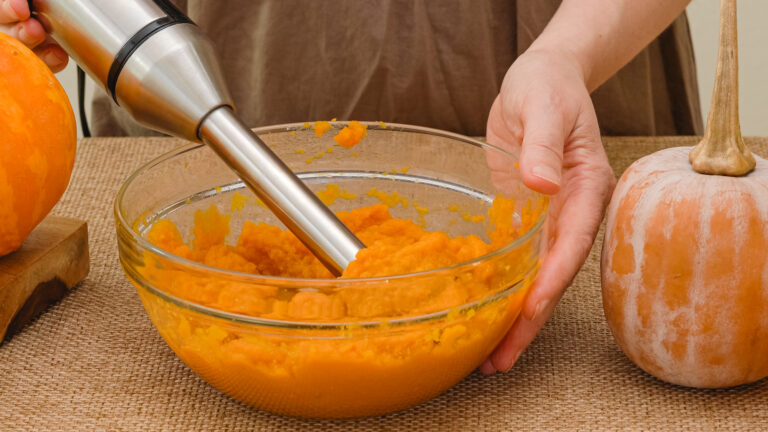If you have a dog, you’re likely to confront the occasional bout of stomach upset (dogs are just too good at sneaking “street treats” and other forbidden fruits to expect drama-free digestion every single day). Depending on the cause and severity of the tummy turmoil, there are some accessible treatments that can help relieve your pup of their discomfort.
One natural way to ease your dog’s minor stomach upset is to feed them plain pumpkin. Yes, this nutrient-rich superfood not only makes a great treat; it’s a reasonably affordable, widely available digestion helper.
Here’s what to know about pumpkin as a stomach aid, and how to feed it to your dog.
The many nutritional benefits of pumpkin
Pumpkin provides a lot of nutritional bang for the buck. A cup of plain pumpkin only contains about 80 calories—but that comes with a healthy 10 grams of dietary fiber, or about 1.25 grams of fiber per ounce.
Like many fresh orange veggies, pumpkin is also rich in beta-carotene and other antioxidants which may reduce your dog’s risk for cancer and promote healthy vision. Pumpkin contains lots of vitamin A, which also helps with dogs’ eyesight, but is an equally important nutrient for healthy skin, teeth, and bones.
To unlock these benefits, though, it’s important to make sure you’re only feeding plain pumpkin with no sugar, spices, or other additives.
Why pumpkin is an effective treatment for upset stomachs in dogs
Pumpkin can actually help with both of the “Big Two” digestion issues—diarrhea and constipation. This is because pumpkin, as noted, has plenty of soluble fiber, a key component in keeping your dog’s digestion running smoothly.
Fiber adds bulk to the stool, facilitating a normal rate of waste movement through your dog’s intestines. The fiber in pumpkin also helps absorb excess water, potentially alleviating diarrhea.
Fiber also promotes the growth and supporting the activity of helpful bacteria in your dog’s digestive tract and helping to keep potentially harmful bacteria in check.
When to use pumpkin to treat an upset stomach
No food is a quick cure-all for a serious digestive disorder. So it’s important to determine the nature of your pup’s stomach issues before turning to any remedy.
If their health and behavior has seemed normal, but they have an upset stomach from an episode of “dietary indiscretion”—i.e., grabbing something off the ground—it’s probably safe to start with a bit of pumpkin.
Pumpkin for diarrhea: Diarrhea is a common manifestation of an upset stomach but can be a sign of something more dire. If your dog has one or two rounds of diarrhea but seem otherwise fine, it’s probably nothing to worry about. Try giving your pup a bit of pumpkin with their meal, or as a treat.
If the diarrhea persists for more than a day, or there’s blood or excessive mucus in it, be sure to speak to your vet. And make sure your dog is drinking water as diarrhea can dehydrate your dog pretty quickly.
Pumpkin for constipation: If your dog misses their regular once-a-day poop, they may be constipated. If they’ve only missed a day of pooping, you can try a bit of pumpkin. If their digestion has really slowed down and they haven’t pooped in a few days, or they’re straining and uncomfortable when they do poop, be sure to speak to your vet. Constipation seems like a mild, everyday issue, but if it persists, it can indicate, or turn into, a serious problem (read more about constipation here).
How to use pumpkin to treat your dog’s upset stomach
You can cook your own pumpkin or purchase it canned.
If you’re using store-bought pumpkin, make sure that it’s 100% pumpkin with no sugar or other additives, which may upset your dog’s stomach even further. Some canned pumpkin has a lot of added salt, which should be avoided. It’s also important to watch out for pumpkin pie filling. This is very different from pure pumpkin and the sugar and spices are not something your pup’s stomach will appreciate. The excessive sugar will also upset the balance of your dog’s microbiome, which may cause your dog’s symptoms to be prolonged or worsened.
If you’re cooking pumpkin at home, try cutting up pieces of the fruit (yep, pumpkin is a fruit), boiling in unsalted water until cooked through and then mashing it. Again, skip the butter, salt, or spices. You can store your pumpkin puree in your fridge for three or four days. You can also freeze it in small portions and it will keep for a few months. Be sure to remove all seeds and skin before feeding the cooked pumpkin to your dog, and make sure it isn’t too hot before serving.
If you’re so inclined, you can roast pumpkin seeds as a stomach calming ingredient to add to your dog’s food. Roast your pumpkin seeds at 350°F, let them cool, and crush them up before adding to your dog’s dinner.
As with any new food introduced to your dog’s diet, it’s recommended that you start with small amounts, increasing gradually until you’re sure your pup will tolerate it.
Depending on your dog’s size, mix from one to three tablespoons of pumpkin into their normal food, or if they like pumpkin, they can eat it on its own.
Remember, if your dog has diarrhea or constipation or is vomiting (or any of these things in combination) for more than a day, it’s a good idea to get them checked out by a vet. A vet will do a physical examination and provide you with advice on what the underlying problem might be and what steps should be taken to address it.





